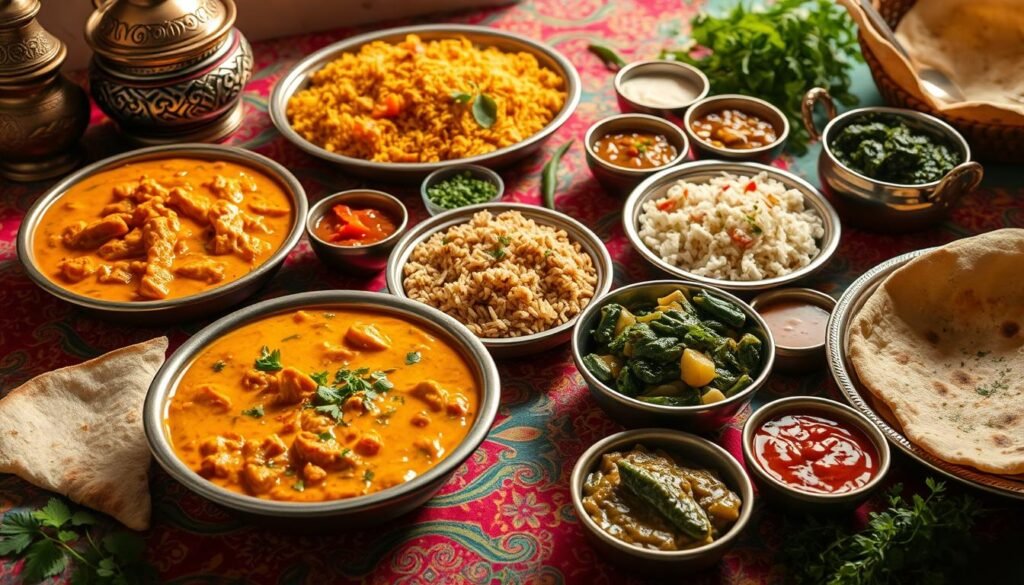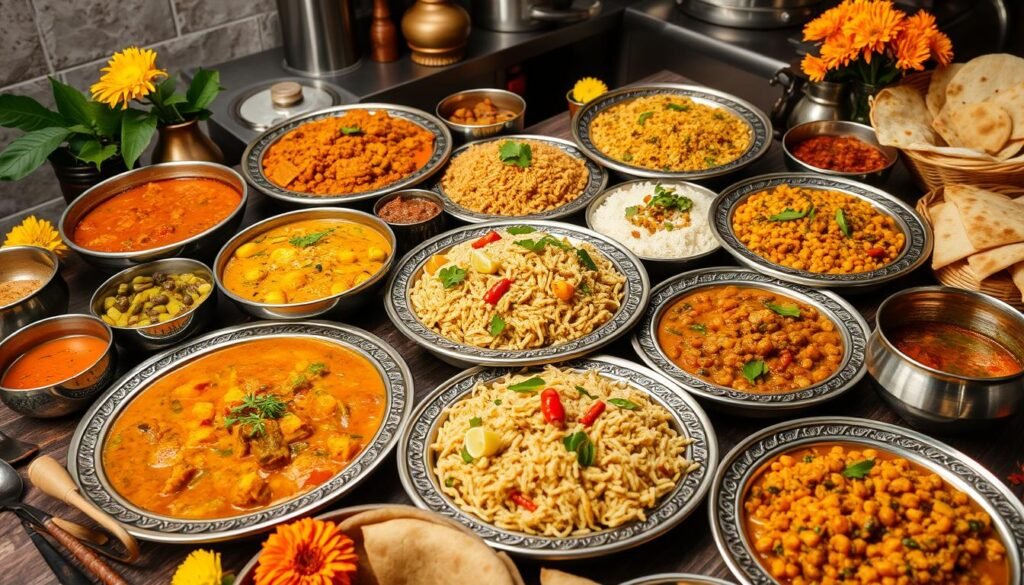Indian cuisine offers a world of diverse and flavorful traditional dishes. Its rich food heritage blends aromatic spices, vibrant colors, and age-old cooking methods. These elements have made Indian food popular worldwide.
The country’s cuisine varies greatly from region to region. Northern India is known for its sizzling curries. Southern India specializes in delicate rice preparations. Each area has its unique flavors and cooking styles.
This article explores classic Indian recipes that have endured over time. We’ll dive into the cultural importance and history of Indian cooking techniques. Get ready to discover the essence of Indian cuisine!
Key Takeaways
- Discover the diverse and flavorful world of traditional Indian cookwer dishes.
- Explore the rich gastronomic heritage of India, featuring aromatic spices, vibrant colors, and centuries-old cooking techniques.
- Journey through the culinary landscapes of India, from the sizzling curries of the north to the delicate rice preparations of the south.
- Uncover the top traditional Indian recipes that have stood the test of time.
- Gain insight into the cultural significance and historical evolution of Indian cooking methods.
Understanding the Rich Heritage of Indian Cuisine
India’s culinary landscape is a tapestry of diverse cultural influences. It reflects historical legacies and regional traditions. From the Himalayas to the coasts, regional indian recipes and spices and flavors of india have evolved over centuries.
Cultural Significance in Different Regions
Indian cuisine is deeply rooted in cultural and religious traditions. The north boasts Mughlai cuisine, showcasing opulent flavors of the Mughal empire. Punjabi dishes are known for robust spices and hearty preparations.
In the south, Malayali and Chettinad cuisines draw inspiration from coastal communities. They celebrate the bounty of the sea with vibrant flavors.
Historical Evolution of Indian Cooking Methods
- The ancient Vedic traditions laid the foundation for aromatic spices and slow-cooking techniques.
- Invaders, traders, and settlers introduced new ingredients and cooking styles to India.
- The fusion of diverse culinary influences created the rich tapestry of regional indian recipes.
Indian cuisine’s evolution reflects the country’s resilience and cultural richness. Its flavors continue to enchant culinary enthusiasts worldwide.
Essential Spices and Ingredients in Traditional Indian Cooking
Indian cuisine’s complex flavors come from unique spices and ingredients. These elements form the heart of authentic Indian cooking techniques. They range from vibrant turmeric to earthy cumin.
Spices are the foundation of Indian culinary traditions. Turmeric adds golden color and a slightly bitter-sweet taste to curry powders. Cumin brings warmth and nuttiness to many savory dishes.
Key ingredients also define Indian cuisine’s character. Ghee, or clarified butter, provides a rich, nutty flavor to various dishes. Yogurt is versatile, used in marinades, sauces, sweets, and drinks.
| Spice/Ingredient | Flavor Profile | Common Uses |
|---|---|---|
| Turmeric | Vibrant golden color, slightly bitter, slightly sweet | Curries, rice dishes, marinades |
| Cumin | Warm, slightly nutty | Curries, rice dishes, spice blends |
| Ghee | Rich, nutty | Cooking, sautéing, baking |
| Yogurt | Tangy, creamy | Marinades, sauces, drinks, desserts |
These elements are essential to spices and flavors of india and authentic indian cooking techniques. They create the unique tastes that have won over taste buds worldwide.
North Indian Culinary Delights: A Flavorful Journey
North Indian cuisine offers a sensational culinary adventure. It’s known for its diverse and vibrant flavors. Iconic regional recipes and non-vegetarian delicacies captivate food lovers worldwide.
Popular Punjabi Dishes
Punjabi cuisine bursts with bold spices and rich textures. Butter chicken is a beloved classic with tender meat in velvety tomato sauce.
Another favorite is rogan josh, a Kashmiri specialty. It features tender lamb in a fragrant, aromatic gravy.
Kashmiri Specialties
Kashmir’s culinary wonders are unique and delightful. Yakhni is a succulent lamb curry infused with aromatic spices and yogurt.
Dum aloo showcases the region’s distinct flavors. This potato dish is tinged with saffron, creating a flavorful experience.
Mughlai Cuisine Highlights
Mughal-era culinary traditions greatly influence North Indian cuisine. Biryani is a fragrant rice dish layered with meat and spices.
Korma exemplifies the Mughlai influence with its creamy, nutty curry. These dishes showcase the opulence of Mughlai cuisine.

South Indian Kitchen Treasures
South Indian cuisine is a vibrant blend of rice, lentils, and coconut flavors. It features iconic dishes like dosa, soft idli, and comforting sambar. These vegetarian indian dishes and regional indian recipes have won hearts worldwide.
South Indian cooking’s charm lies in its unique techniques and traditional methods. Fermentation, steaming, and spice grinding create deep, complex flavors. The cuisine masterfully balances chili heat, earthy dal, and creamy coconut.
| Iconic South Indian Dishes | Key Ingredients | Unique Cooking Methods |
|---|---|---|
| Dosa | Rice, lentils, coconut | Fermentation, griddle cooking |
| Idli | Rice, lentils | Steaming |
| Sambar | Lentils, vegetables, spices | Simmering, tempering |
South Indian regional indian recipes offer a feast for the senses. Vibrant colors, aromatic spices, and time-honored traditions shine in every dish. Mastering idli-making or exploring sambar’s complexities reveals South India’s rich culinary heritage.
Must-Try Indian Cookwer Dishes in India
India’s culinary landscape is a feast for the senses. Explore the diverse flavors of indian cookwer dishes across the country. Each dish reveals authentic indian cooking techniques perfected through generations.
Regional Variations
India’s vast landscape creates a tapestry of regional cuisines. Each area boasts unique ingredients, spices, and cooking methods. Let’s explore some mouthwatering specialties from different states:
- Spicy and aromatic curries from the north, such as Rogan Josh and Nihari
- Tangy and coconut-infused dishes from the coastal regions, like Malabar Fish Curry and Goan Vindaloo
- Fragrant rice dishes and dosas from the south, including Biryani and Masala Dosa
- Earthy and wholesome lentil-based delicacies from the central states, such as Dal Makhani and Chole Bhature
Cooking Techniques
Indian cookwer dishes are built on time-honored cooking methods. These techniques have been refined over centuries. Let’s uncover the secrets behind these culinary masterpieces:
- Slow-simmered curries that unlock the depth of flavors
- Tandoor-grilled meats and breads that impart a smoky essence
- Meticulously layered biryani dishes that blend spices and grains to perfection
- Delicate hand-rolled and steamed dumplings that showcase the art of precision
Dive into the world of indian cookwer dishes and discover their hidden depths. Experience the magic of authentic indian cooking techniques that make this cuisine a global favorite.
Authentic Vegetarian Delicacies
India’s culinary heritage boasts a diverse array of vegetarian indian dishes. These meals showcase the country’s mastery of plant-based cuisine. From comforting dal makhani to creamy palak paneer, traditional Indian food offers mouthwatering experiences.
The Thali is an iconic example of Indian cuisine. It’s a platter featuring various vegetarian dishes, each with unique flavors and textures. Regional specialties like Bread Pakoda, Khumb Matar Malai, and Kerala Vegetable Kurma often appear on Thalis.

Indian vegetarian cuisine also includes fusion creations. The Bombay chilli cheese toastie is a spicy and cheesy delight. These dishes showcase the creativity of Indian cooking.
- Bread Pakoda
- Khumb Matar Malai
- Kerala Vegetable Kurma
- Bombay chilli cheese toastie
The cookbook “Thali” explores regional variations of Indian vegetarian cuisine. Another book, “Tandoori Home Cooking,” focuses on tandoori techniques. Both provide insights into preparing traditional Indian food at home.
Traditional Non-Vegetarian Specialties
India’s culinary landscape offers diverse flavors and rich non-vegetarian traditions. These delicacies have won over food lovers worldwide. From tandoori dishes to coastal seafood, India’s non-vegetarian cuisine is a treat for the senses.
Tandoori Preparations
The tandoor, a clay oven, is central to many iconic Indian dishes. Tandoori chicken, marinated in spices and yogurt, is a classic non-vegetarian indian delicacy.
This dish showcases the smoky, succulent flavors of tandoor cooking. Lamb and paneer also shine in the tandoor. They create tasty popular indian curries like tandoori seekh kebab and paneer tikka.
Coastal Seafood Dishes
India’s long coastline provides a wealth of fresh, flavorful seafood. Southern states offer aromatic fish curries, while eastern regions boast delectable prawn dishes.
These coastal areas have produced some of India’s most mouthwatering non-vegetarian indian delicacies. Goan fish curry, Kerala-style prawn curry, and Mangalorean seafood thali are standout examples.
Street Food Favorites Across India
India’s street food scene is a culinary treasure trove. It offers mouthwatering snacks that reflect diverse regional flavors. These delights have become iconic symbols of Indian cuisine.
Chaat is a beloved street food favorite found across India. It’s a delightful blend of flavors and textures. Chaat showcases local cooks’ ingenuity in balancing sweet, sour, and spicy tastes.
Vada pav is another standout street food specialty from Mumbai. This simple snack features a deep-fried potato patty in a soft bun. It’s often served with chutneys and spices that tantalize taste buds.
| Popular Street Food Dishes | Regional Variations |
|---|---|
| Chaat | Panipuri (North), Sev Usal (West), Bhel Puri (Mumbai) |
| Vada Pav | Dabeli (Gujarat), Kachori (Rajasthan), Samosa (Nationwide) |
| Kebabs | Seekh Kebab (North), Chicken Tikka (Punjab), Shami Kebab (Lucknow) |
These street food favorites satisfy locals and captivate visitors’ taste buds. They showcase the street food of india and regional indian recipes. These dishes have been passed down through generations.
The street food of india is a culinary adventure waiting to be savored. You can explore it in Delhi’s bustling markets, Kolkata’s vibrant alleys, or Chennai’s lively streets.
Modern Interpretations of Classic Indian Recipes
India’s culinary scene is changing. Chefs are reimagining traditional dishes for modern tastes. They’re blending classic Indian flavors with global ingredients and techniques.
This fusion creates a new wave of exciting cuisine. It offers a fresh take on beloved favorites. The result is a delightful mix of old and new.
Fusion Elements
Chefs are pushing boundaries in Indian cooking. They combine Indian spices with global seasonings. They also add unexpected textures and presentations.
This approach honors India’s rich culinary heritage. At the same time, it appeals to modern preferences. It’s a creative way to update classic recipes.
You may also read: How xxx porn Has Shaped Online Viewing Habits Over the Years.
Contemporary Cooking Methods
Modern techniques are transforming traditional Indian dishes. Chefs use molecular gastronomy and sous vide cooking. They also focus on innovative plating.
These methods enhance flavors and visual appeal. They create a perfect balance between tradition and innovation. The result is a unique dining experience.
